Collaborative thinking can help foster creativity. If the collective works the right way, a group studio has great potential to help visual artists bring out more original and exciting ideas. Why not learn from the best in the creative field; Pixar Studio.
By Thomas Bjørnskau, editor of startjournal.org.
Pixar Studio is known for animation movies like Toy Story and The Incredibles. In the world of creative industries it is renowned for being the model of a cutting-edge, forward thinking, innovative company. Maybe most relevant for the East African art scene are the principles and guidelines for team creativity which they base their work upon.
Kampala is currently home to at least three group studios, providing an artistic space for close to twenty visual artists. Startjournal has spoken to a dozen of these artists to find out whether the lessons learned from teams like Pixar would be applicable for the field of fine arts.
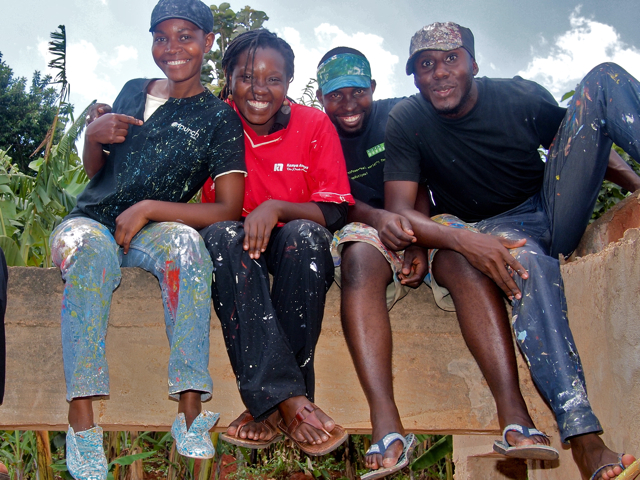
Artists from Artpunch Studio
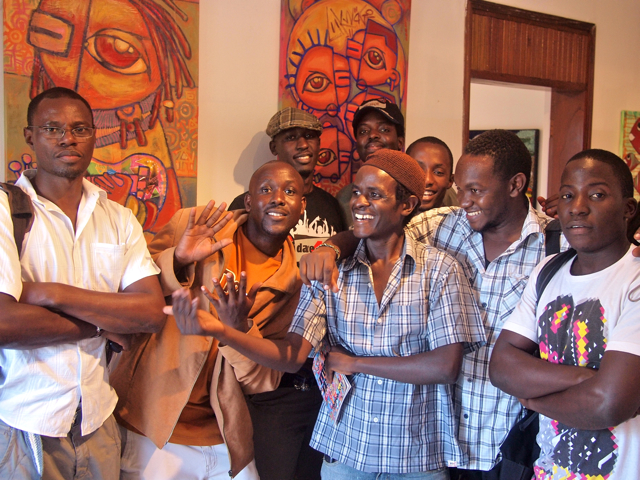
Artists from the Njovu Art Studio
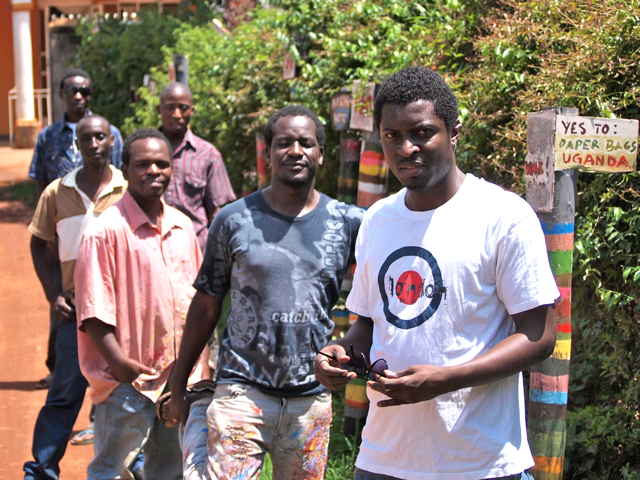
Artists from the Ivuka Arts Studio
Innovate the Pixar Way
At the end of the day, the Pixar teams work towards one shared end product, which of course makes it different from a group of individual artists producing separate art works. Nevertheless, when reading about Pixar’s approach to creative work, there are good reasons for why these collaborative techniques and guidelines may work for a group that produces many individual objects.
So, what makes Pixar so special? Even though Pixar now is a part of bottom-line obsessed, hidebound, bureaucratic Disney, it has managed to retain its role as a creative corporate playground. The book ”Innovate the Pixar Way” explains some of the major reasons for this:
- Develop and stick to a long-term vision
- Make fun and play part of the daily work routine
- Keep all communication channels open and display mutual respect and trust when collaborating
Furthermore, Pixar’s greatest strength is its willingness to fail. Its principles for encouraging risk and creating a ”TRY, LEARN, and TRY AGAIN” culture include:
- Honoring failure like success
- Quickly creating prototypes of new products for rapid testing
- Giving teams unlimited freedom to see what they can create
- Asking team members for 10 of their most imaginative, least-grounded solutions
- Using financial restrictions as strengths and developing within existing capabilities
- Displaying team ideas, in planned or real forms, for all to understand
- Seldom asking for permission
- Implementing ideas as they arise
- Seeking purchasers or suppliers who match the group in flexibility and forward thinking, because such allies become real-world testers for even the wildest notions
Like all great advices, some of these principles would feel a matter of course. But Startjournal wanted to discover the inner dynamics of the group studios in Kampala, and initiate a discussion with group artists using these guidelines as a backdrop.
Striking art from Artpunch
Artpunch Studio is the home of frontman Wasswa Donald and fellow visual artists/fashion designers Amos Sentongo, Sheila Nakitende and Nabukenya Hellen. They work from a new studio in Kansanga and they have been operating as a group since 2007; with Nakitende joining last year.
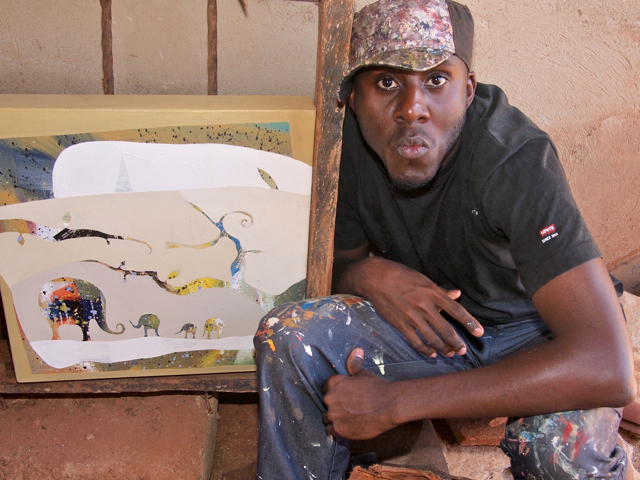
Donald: "In this painting, Amos taught me how to incorporate the use of collage in the background"
Wasswa always wanted to start a group studio and explains the main reasons: ”In a group you will work faster, because the rest of the group will push you forward, inspire you in a positive way.”
Sheila agrees and describes her reasons for joining: ”I joined Donald’s group last year, feeling it was ’on the move’. The group gives you a sense of belonging, there is a fusion of different personalities, but there is no judgement, I get the drive from likeminded people, and at the end of the day; a group is the best way to be encouraged to work.”
Sheila: "In this one, the group helped me understand form and perspective"
Wasswa relates the group’s vision to the latter part of the chosen name of the group; punch. ”This word reflects both how we work and the effect we like our art to have on the audience. Even though each artists’ work needs to stand out in itself, our shared vision of striking art must be present.”
Looking around at the different art works in the studio, this writer would agree to the notion that there is a certain common denominator to the creations. These days more than one group member seem to explore the effect that splattered paints will have on different media, ranging from canvas to shoes, bags and mirrors.
Artpunch seems to be fond believers of the principle of quickly creating prototypes for rapid testing. Nabukenya is working on a collection of customized shoes, using the above-mentioned technique: ”Last year I wore some shoes covered in accidentally spilled paint – as artists often do – to a party, and this pair of sneakers caused such a good response that I wanted to pursuit the idea of creating a set of customized products.”
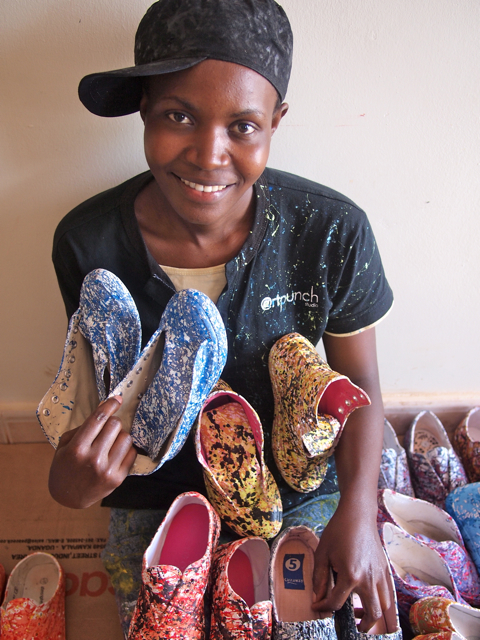
Hellen: "The group advised me how to apply paint to cover the whole of the edge of the sole"
Out of the three groups Startjournal spoke to, Artpunch seems to be the group which best have adapted the guidelines of coming up with imaginative ideas, implementing them as they arise, and seeking allies outside the group to test and give feedback to such ideas. Wasswa explains that this is more an ongoing process than consciously using collaborative techniques to foster product innovation.
That also seems to be the approach to how the group works with displaying each artists’ individual ideas and commenting on each others art works. ”Especially when another artist start talking about signing an art piece, each one of us would be alert and almost drawn to the piece. We would focus our comments on elements that are missing or just brought out wrong, often taking the role as the viewer or the curator.”
Wasswa further explains that these processes are ever-present, quite unformal and based on a trust and honesty in the relationship. ”A kind of trust and honesty that was an important factor for me when I decided to join the group,” adds Sentongo.
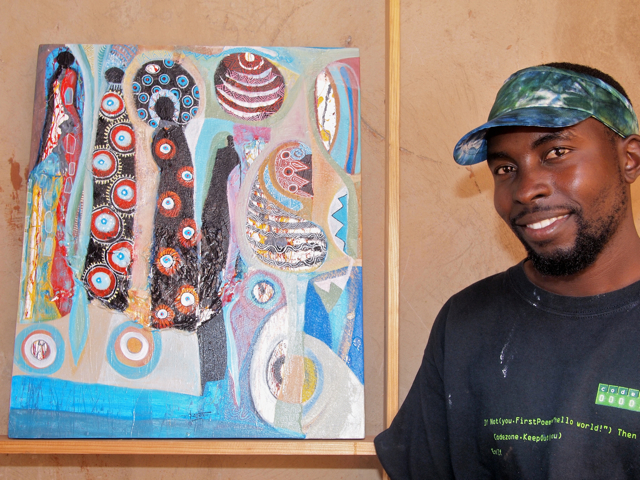
Amos: "I was adviced by the group to make a personal painting, hence the use of fabrics to relate it to my background as a fashion designer and depicting the women to pay tribute to the women I was raised by"
Njovu Art Studio
Njovu Art Studio is a result of some members leaving Gecko Studio in late 2009. This split demonstrates another fundamental principle of teamwork. There is a need for a shared group ideology and artists who team up for similar reasons.
When talking to some of the group members, there seems to be an immediate point to explain why Gecko didn’t work out and reasons for this group to come into being. But after Startjournal explains that this article is forward-looking, the Njovu artists are happy to share their view on which are the important factors to base a collaboration on.
Njovu Art Studio did recently have to move from Bukoto to Ntinda, and because of that they haven’t really worked as a group the last couple of months. As Arnold Birungi, an artist and an illustrator who joined Damba Ismail, Mark Kassi, Tindi Ronnie and Ngula Yusof when they separated from Gecko Studio, explains: ”We are still in the phase where we are getting firm as a group.”
Arnold: "Damba suggested that the arm in the background should be brushed off to leave my usual realistic touch"
”We have a democratic approach to everything we do. When somebody from outside contacts a group member with a request, our next step will be to gather the group and discuss how to act,” Mark Kassi adds.
Njovu also includes Damulira Shira, and Saad Lukwago and Kasagga Jude, the two latter being based in Masaka. Other values which Njovu is founded on are:
- recruting a new artist every year; currently Oscar Barigye is working together with the more experienced artists
- assigning specific roles to some group members; Birungi acting as director, Kassi acting as treasurer, and Damba as PR and marketing person
- having a more exclusive approach to the market; ”you will not find our art works everywhere”
”One advantage there is by working in a group, which makes everybody more creative, is just the fact that everybody see what you do. One technique we sometime do, is to challenge another artist to do something differently. For instance, I would ask Arnold to make something abstract,” explains Damba.
Damba: "Anyone in the group is free to comment and react"
The displaying of ideas and the openness to comment, discuss and criticize more or less finished art works, seems to be the guideline these visual artists easiest recognize.
”One thing at least Mark and I used to do a lot – even though we hadn’t established it as a formal collaborative technique – was to hang a newly finished painting on a nail just outside the entrance. This meant we were open for – or even yearning for – others to critique it,” Tindi explains.
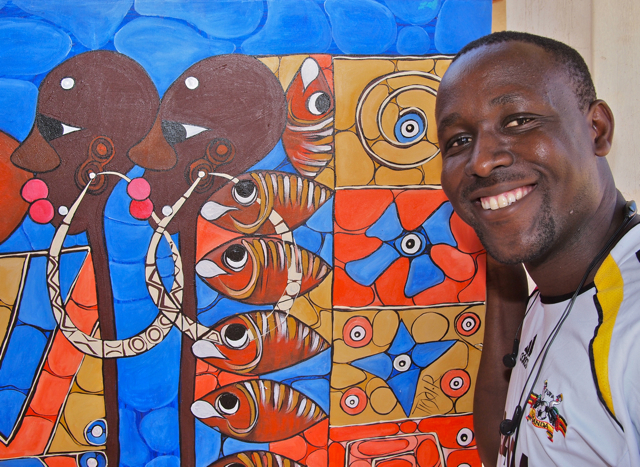
Tindi: "The group challenged me to add more details in my work and how to compose them"
”An important factor in the group is that we are all open for the idea of criticizing and be criticized. It is an ongoing process, we are always asking colleagues to comment what we are working on. But it is also important to say that it is done with a certain degree of humour. Sometimes we throw out a funny comment, just to break the ice,” Mark Kassi adds.

Kassi: "The group adviced on how to apply and finish the dark background to the left"
When the group is presented with some of the other guidelines for innovative team work, it is apparant that some of artists are applying them on an individual basis, but seldom consciously in formal group processes.
Using art to change lives
Similar conclusions can be drawn after speaking with a third group, with equally many members as Njovu; Ivuka Art Studio. They share a history by arising out of Gecko studios.
Startjournal meets five of the members; Jjuko Hoods, Anwar Sadat Nakibinge, Paul Kintu, Patrick Kyeswa and Albert Walozi, in their second floor home base in Bukoto. In addition, the group currently consist of Collin Sekajugo, who introduced the current name, Ssebandeke Mohamed, Ibrahim Kitimbo and Cathrine Kabugo.
Jjuuko Hoods explains some of the main benefits of working in a group studio as Ivuka: ”First, we provide a space for young artists. A space which is organised in a formal manner so that one doesn’t have to think about rent etcetera. But maybe more important; being part as a group gives you a freedom to expression, you let go of the fear to execute your ideas, simply because the other artists will give you strength, inspire you and push you forward. At the end of the day, it will enhance your confidence as a visual artist.”
Jjuuko: "The group inspired and challenged me to use old posters as a collage"
The group members feel at home when we discuss principles like ’using financial restrictions as strength’. These artists are used to work with limited resources, experimenting with all sorts of free and accessible media and material, and producing their art on things like old posters, jeans and other waste objects.
The more experienced group artists like Jjuuko Hoods and Anwar Sadat Nakibinge points out that one of the core values for this studio is to embrace young artist that comes from scratch.
Albert: "The other artists adviced me on how to build the patterns, the shapes, the colours and distribution"
”It is almost like a sharing program, where we show unexperienced artists how to maximize their sense of creativity, how to become more confident and develop an unique style,” Anwar explains and continues. ”The same thing applies to giving feedback. There is a deep respect for comments, and never any bad feelings.”
Anwar: "The group challenged me to use oil paint instead of acrylics"
”I would say that our ways of giving feedback are spontanous, they are very direct and open, and always with the intention of giving specific advices,” adds Jjuuko.
Upon the topic of building alliances to outside players, this group has always been engaged in community projects. They were approached by and teamed up with Aidchild and Nsambya Babies Home, and has actively worked to establish a relationship with Kansai Institute. Engaging themselves to help the Mulago and Masaka communities, have also been important steps that underlines their slogan ”Using art to change lives”.

Paul: "The group adviced me to attach the small painting to a dark background, hence giving it a more powerful appearence"
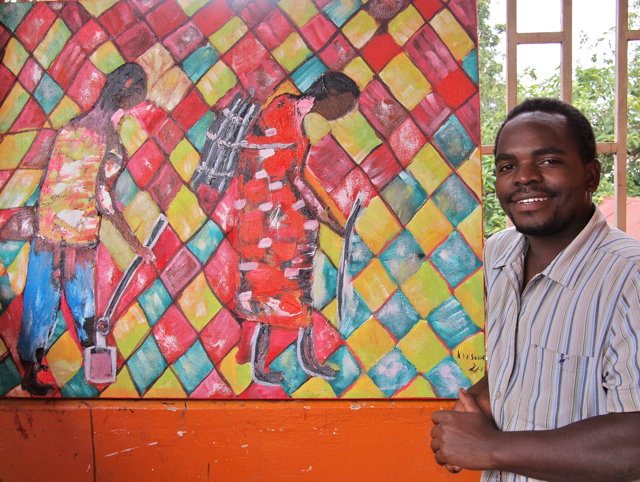
Patrick: "In this painting the group adviced on how to carry out the diamonds in the background, how to work on the outline and the colour in them"
A potential for further innovation
After having visited and discussed these issues with three of the leading group studios in Uganda, this writer has a feeling that the collectives are doing great things for individual artists. Which contributes a lot to make each artist stronger and more confident than they would have been in splendid isolation.
Nevertheless, one can not help thinking that some simple collaborative techniques and guidelines may help to break up the tradition of the ongoing, yet quite spontanous teamwork that exist today, and maybe challenge the groups to think outside the box.
GREAT ARTICLE...LOVE THE EXAMPLES OF COLLABORATION AND FEEDBACK. "USING ART TO CHANGE LIVES" IS FAR MORE THAN A SLOGAN...IT'S A PRACTICE THAT WE WISH WAS CHERISHED BY MORE SCHOOLS AND BUSINESSES HERE IN THE US. BILL AND LYNN








 I am pleased to extend my warmest greetings to everyone attending the 13th World Human Resources Congress, organized by Quebec’s Ordre des conseillers en ressources humaines agréés.
I am pleased to extend my warmest greetings to everyone attending the 13th World Human Resources Congress, organized by Quebec’s Ordre des conseillers en ressources humaines agréés.













